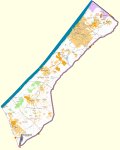
home
 |
Palästina
- Israel home |
PalisD |
|
My third visit to Gaza
April 21 to May 3, 2012 Peter Voss  UNRWA and the World Food Programme (WFP) The main responsibility for the care of the poor population in Gaza is overwhelmingly with UNRWA and the World Food Programme (WFP). Both are agencies of the United Nations. As the name already expresses, UNRWA is responsible solely for the Palestinian refugees, while the WFP operates worldwide. For both organizations there are articles on Wikipedia. UNRWA was established on 01/05/1950 for the care of Palestinian refugees and their descendants. Its headquarters is located in Gaza. The WFP takes care of the non-refugee part of the needy population In Gaza. An idea under which guidelines and under which conditions these organizations work provide reports and requests of these organizations to which I would like to refer in some detail. A file "UNRWA in figures" lists the main data for various regions in which UNRWA is active, among them Gaza. The UNRWA publishes in contrast from the World Food Programme no specific figures for individual food aid. The WFP is limited almost entirely to food aid. In 2012 it serves (or at least plans to serve) 285 000 people that are considered extremely poor, i.e. have less than U.S. $ 2.7 per day. This includes the support of orphanages and foster homes, as well as the issueing of school meals and the provision of educational opportunities in skilled trades. The appeal of the WFP
for 2012 (21 pp., 91
MB!)
gives an insight into the work of this organization in Gaza and on the
conditions under which it works there. I extracted some data and some
quotes.
The $ 12 - Coupon value
indicated in the table I have bracketed. It refers to one month.
Compared to the
situation of 2010
the meat ration was removed and the 'high-energy biscuits' have been
replaced with date bars. The cost per person per day has increased from
$ 0.35 to $ 0.40. The data on the weight of the issued food is
inconsistent. The data resulting from the above table is 378 g per
person per day, from the lower one it is 504 g In 2010 there were
approximately 550 g per day. The values given for calories per day and
person have remained about the same. A distribution of milk is no
longer mentioned.
The WFP apparently aims to change the system of issueing food parcels, which are distributed every two months (at the UNRWA every three months) and accordingly extensive, to an issuing of electronic coupons that can be redeemed on a weekly basis in special stores. For the five-member family such purchase would have a value of $ 14 The aim is to create the opportunity to possibly buy some higher quality food. So at least goes the theory. UNRWA and the WFP currently have big problems to collect the money for their projects. In the WFP appeal one reads under paragraph 42: "In the event of funding shortfalls during 2012, WFP envisages: a reduction in the in-kind ration quantity (three-month instead of two-month distributions); simplification of the food basket (items such as salt and sugar would be the first commodities to be removed); and a reduction of the voucher value." Such a situation appears to have occurred in early 2012. The Monthly Humanitarian Monitor reported in April: "Funding constraints continue to hamper the humanitarian community’s ability to respond to the humanitarian challenges in the oPt. So far in 2012, both Consolidated Appeals (CAP) and UNRWA’s Emergency Appeal are underfunded, registering at 38 percent and 25 percent of requested funding, respectively . This month, the funding shortage has resulted in a temporary reduction in UNRWA food rations provided to approximately 680,000 refugees in Gaza." The number corresponds almost exactly to the number of 'absolute poor'. Due to the funding gap already several employment contracts were already terminated at the beginning of the year. In addition, in 2012 there are no more UN summer camps for children. In sum, about 925 000 of the approximately 1.6 million people in Gaza are supported by UNRWA and WFP with food aid. Up till now people could at least rest assured that this assistance would be also provided. With all the misery they were still better off than many people in other parts of the world. No one is starving. The only question is how people would live, if the Israel-Palestine conflict did not exist. For farmers in Shijeaya this answer is somewhat simpler to answer than for the people in the refugee camps. In between there are many nuances like the normal poor farmers or the low-salaried employees that are likely to receive their salaries only very irregularly. For the people supported by UNRWA the situation seems to have worsened during the past two years, starting from the high emergency level that became necessary through the Israeli attack the support has continuously deteriorated. An emergency appeal which was probably written about in August 2011, conveys the dramatic situation. |
||||||||||||||||||||||||||||||||||||||||||||||||||||||||||||||||||||||||||||||||||||||